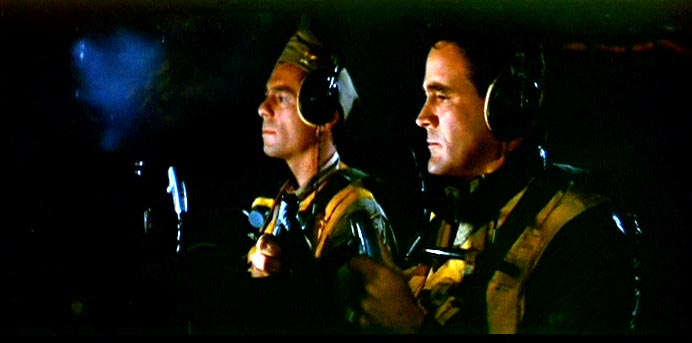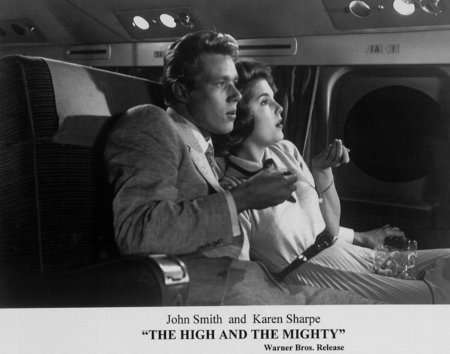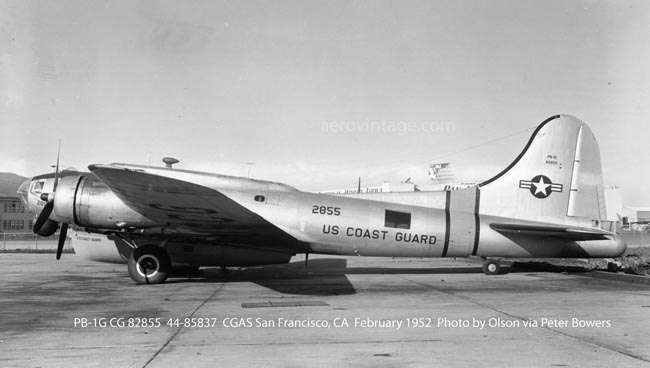| Title | The High and the Mighty |
| Studio | Warner Brothers |
| Date of Release | July 1954 |
| Producer | Wayne-Fellows Productions |
| Director | William A. Wellman |
| Actors | John Wayne, Claire Trevor, Robert Stack |
| Aerial Coordinator | USCG (PB-1Gs), Paul Mantz (?) |
| B-17 Filming Locations | CGAS San Francisco |
B-17s Used
PB-1G CG 82855 (ex 44-83857)
The Movie...
The 1950s aviation classic tells the story of trans-Pacific DC-4 airliner that, enroute from Hawaii to San Francisco, has engine problems that threaten to put the airplane in the ocean. John Wayne plays a veteran, experienced, weathered, seasoned copilot and Robert Stack the stiff, marginally competent captain. John Wayne gets to slap Robert Stack, to try and put some backbone into the boy. Lots of passenger angst, anguish, conflict, crying, hand-wringing, gnashing of teeth, emotions, and finally (of course), resolution, all surely done better a quarter century later in Airplane (Don't call me Shirley.) And that damn tune, whistled by John Wayne. Of particular interest here, though, is the plot line where a USCG PB-1G (air-sea rescue version of the B-17) gets launched out of San Francisco westbound to meet the strickened eastbound airliner, something that occurred on a regular basis with the old piston engined airliners of the day. Also, some pretty spectacular air-to-air shots of the DC-4 soaring along, those having all the marks of some work by Paul Mantz but he is not credited as such.
Anecdotal
According to IMDB, the DC-4 was N4726V under lease from Oakland-based Transocean Airlines (TOA) and, prior to it being obtained by TOA, was the personal plane of Argentinan dictator Juan Peron. The DC-4, ironically, ultimately crashed or ditched in the Pacific Ocean on March 28, 1964, with the loss of nine people. The airplane reported a serious engine fire while 700 miles west of San Francisco and was not seen or heard from again.Thanks to careful reader John Boyle, the above information is not correct. The correct information is below...The DC-4 used for the air-to-air filming was, in fact, leased from Transocean Airlines and was N4665V, named at one point as African Queen. This was verified by the pilot who flew the sequence, Capt. Bill Keating, as per his letter to the Transocean Airlines newsletter of February 2008. According to Simon Beck's fine The Aircraft Spotters Film and Television Companion, N4665V made twelve flights between November 16 and 30, 1953. The incorrectly attributed N4726V is seen briefly in an early scene in the film on the ground. Also, careful reader John Boyle notes that N4762V might also be the DC-4 seen in the final scenes of the film (with the damaged nacelle and engine) as that aircraft has a cargo door, while N4665V does not, so it was a different aircraft. However, Simon Beck does not document this in his book. Thanks to John Boyle and Simon Beck's book for this correction (8/20/2024)
- The screenwriter was noted aviation author Ernest K. Gann, who also wrote the book the film was based upon.
- From B-17 In Blue, we learn that PB-1G CG 82855 was built by Vega at Burbank and accepted as AAF s/n 44-85837 on July 25, 1945. It was flown to Lubbock, Texas, for storage, and moved to the Rome Air Depot in February 1946. It was earmarked for the USCG through the U.S. Navy, one of 20 new B-17s so earmarked to become USCG PB-1Gs. Only sixteen were actually transferred. CG 82855 went to the Navy in April 1946, was modified at NAAF Mustin Field, Pennsylvania, to the PB-1G configuration, primarily with the addition of search radar in the nose and provisions to carry the droppable Higgins A-1 boat. It was stored at CGAS Elizabeth City between January 1947 and October 1949, it was then assigned to CGAS San Francisco between October 1949 and March 1954. It then went to CGAS New York and then back into storage at CGAS Elizabeth City until 1957 when it was released for disposal. It was reportedly flown to NAS Norfolk and presumably scrapped shortly afterwards. Now you know the history, why buy the book?
- From Bill Stanczak: "The "unidentified" co-pilot in the B-17 is none other than Carl 'Alfalfa' Switzer. He was also a C-47 Co-Pilot in Island in the Sky."
Buy this Movie!
Links
Acknowledgements
- The source on the PB-1G, B-17 In Blue

Nice 1952 shot of PB-1G CG 82855 taken at San Francisco. (Click for a larger view.) At this point the A-1 boat is still mounted under the bomb bay. When the film was shot, the boat was not mounted. At about this time, the Coast Guard elimintaed the wooden boat in favor of inflatable life rafts carried in the bomb bay that could be dropped to downed aircraft. They automatically inflated. (Photo by Mr. Olson via Peter Bowers)

Ramp view from the film of PB-1G 82855.

Screen capture showing the aft fuselage and the typical markings of the PB-1Gs in the early 1950s.

A starting-engine view with the CG serial visible on the nose.

Cockpit view of the PB-1G with, as yet, unidentified actors (whoops, see "Anecdotes"). Presumably, this was one of the several B-17 cockpit mockups that moved around Hollywood in the late 1940s and 1950s.

Oh, the angst of the passengers, doomed to die. No, wait, that's not right. Happy to live, thanks to John Wayne.
